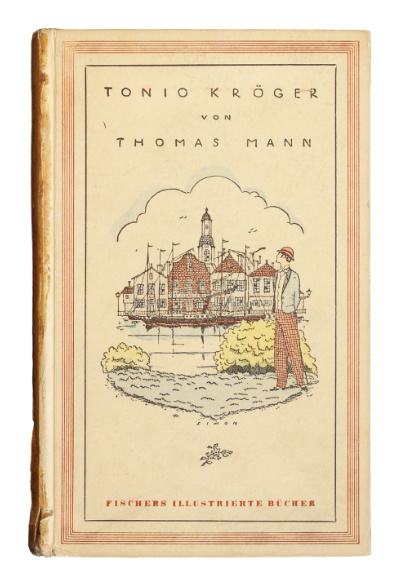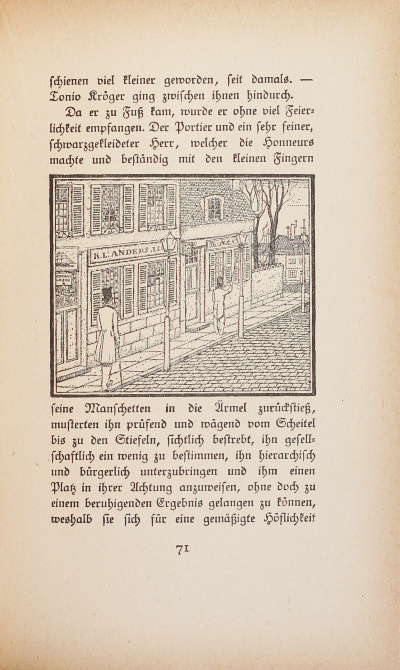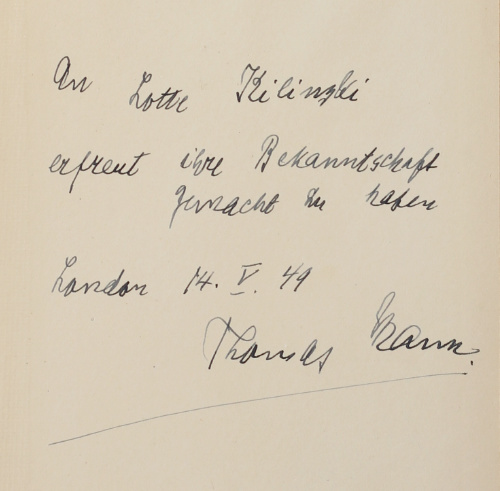MANN’S ‘MASTERPIECE’ TONIO KRÖGER, INSCRIBED BY MANN IN LONDON,
APPARENTLY FOR ‘A REFUGEE FROM NAZI OPPRESSION’
MANN, Thomas. Tonio Kröger. Berlin: Bibliographisches Institut in Leipzig for S. Fischer, 1923.
Octavo (179 x 110mm), pp. 122, [1 (blank)], [3 (author’s works, publisher’s advertisements)], [1 (blank)], [1 (imprint)]. Printed in Gothic type. Title vignette and 17 illustrations after pen-and-ink drawings by Erich M. Simon, 8 full-page. (Lightly browned, more heavily at margins.) Original beige boards, upper board with colour-printed illustration after Simon within ruled frame surrounded by red quadruple ruled frame, upper board and spine lettered in black and red. (Lightly marked, extremities lightly rubbed, bumped and marked, spine worn, partially detached at foot, and with old adhesive tape repair.) Provenance: Lotte Kilinzki (fl. 1899-1965, autograph presentation inscription from Thomas Mann ‘An Lotte Kilinzki, erfreut ihre Bekanntschaft gemacht zu haben. London, 14. V. 49. Thomas Mann’).

First separate edition, 34th-38th thousand. Thomas Mann (1875-1955) began work on Buddenbrooks (1901) – arguably his most famous work – in 1897, in response to a request from his publisher Samuel Fischer for a substantial novel. In the protracted period of writing Buddenbrooks, however, Mann also developed his career as a writer of fiction through other works, and Tonio Kröger, which he conceived on holiday in Denmark in 1899, would become one of his most popular works – famously, in his 1940 introduction to Kafka’s The Castle, ‘Mann even boasts that Kafka loved Tonio Kröger’ (A. Heilbut, Thomas Mann. Eros & Literature(London, 1996), p. 482).
Tonio Kröger was inspired by Mann’s deep affection for the young violinist and artist Paul Ehrenberg, which was at its most intense in the period during which Mann wrote the novella. The novella fictionalises Mann’s teenage infatuation with his classmate Armin Martens, here the ‘warm-hearted athlete, Hans Hansen’ opposite Mann’s Tonio (Heilbut, p. 24). ‘When he was in his seventies, he could recall [this love] as the most “delicate, blissfully painful” time of his life. […] In 1931, when asked to describe his first love, Mann replied briefly that all the details could be found in Tonio Kröger’ (Heilbut, p. 15).

Tonio Kröger was first published by Fischer in 1903 as the concluding novella in the collection titled Tristran. This illustrated, first separate edition was first published in 1918 in an edition of 5,000 copies, and proved to be very popular: further reprintings followed in 1914, 1915, 1916, 1921, then the present 34th to 38ththousand in 1923, and continued further through to 1930 (cf. Bürgin).
The present copy was inscribed by Mann to one ‘Lotte Kilinzki’ on 14 May 1949, when Mann attended and spoke at the meeting of the PEN Club Deutscher Autoren im Auslande and the Thomas Mann Society for Aid of Emigré Writers (founded by Wilhelm Sternfeld) in London. The PEN dinner would be held on 17 May with Mann as a guest as well as T.S. Eliot, whom Mann described in his diaries as ‘rude’ (‘mit […] dem unhöflichen, übrigens zurückgesetzten T.S. Eliot’; Thomas Mann, Tagebücher 1949-1950, ed. Inge Jens (Berlin, 1991), p. 56). Mann had been admitted to the exclusive PEN Club in 1925 after visiting the British branch in the previous spring.

During his visit to England from 11 to 19 May 1949, Mann visited a number of places and organisations, gave speeches and took part in recordings, and attended events not only in London but also in Oxford (where he was awarded an honorary Doctor of Letters on 13 May). He spoke on ‘Goethe and Democracy’ both at Oxford and three days later at the English Goethe Society, and Goethe also featured in his address at the PEN dinner. Mann’s visit to London would conclude with his talk at the Wiener Library on books published in Nazi Germany on 18 May, and on the following day with a farewell reception at the Savoy Hotel hosted by Martin Secker and Frederic Warburg, Mann’s London publishers.

The woman to whom this copy is inscribed, ‘Lotte Kilinzki’, must have acquired it prior to Mann’s appearance at the PEN and Thomas Mann Society reception (possibly years earlier), although it is not clear whether she purchased it in Germany or in the UK. She may have been the secretary Lotte Kilinski who was listed at 105 Lutzowstrasse, Berlin in the Berliner Adreßbuch 1930 (Berlin, [?]1930), I, p. 1540) and, presumably after fleeing Germany, as the Berlin ‘Refugee from Nazi oppression’ Lotte Henriette Kilinski (aged 41), who was interned at Rushen Camp, Isle of Man in 1940-1941 and did ‘not desire to be repatriated’ (Manx National Heritage Museum iMuseum). Lotte Kilinski later moved to London, where she worked as a secretary after the war and was naturalized on 29 July 1947 (London Gazette, 19 September 1947, p. 4402). Some two decades later she apparently donated to the ‘Thank-You Britain Fund’, since her name appears in the Preliminary List of Donors, 15 March 1965, appended to Information. Issued by the Association of Jewish Refugees in Great Britain (March 1965).
H. Bürgin, Das Werk Thomas Manns, I, 9.
£450
· · · · · · · · · · · · · · · · · · · · · · · · · ·
Our Terms & Conditions apply.

